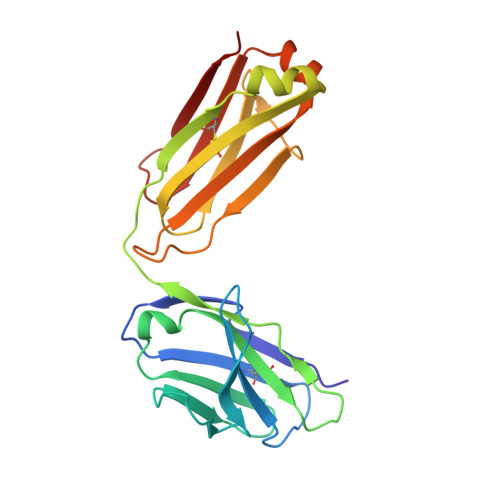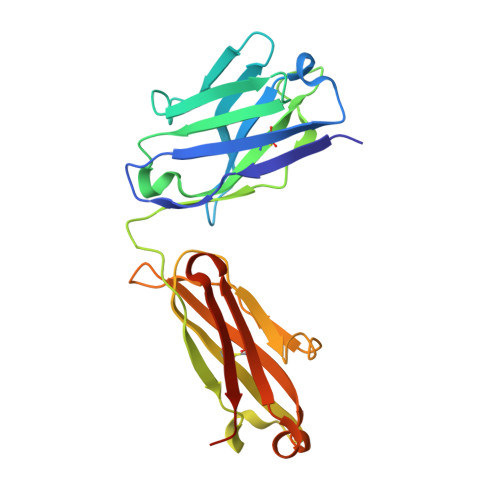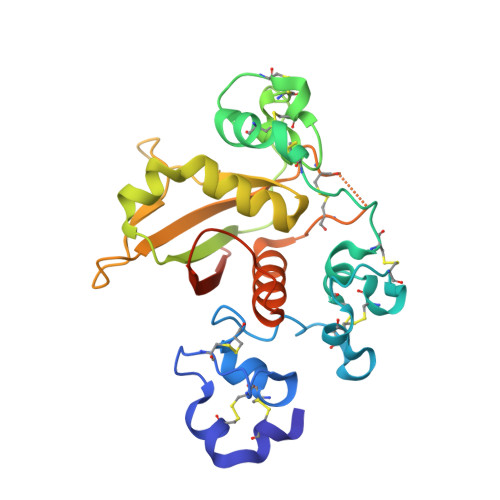Therapeutic antibody targeting of individual Notch receptors.
Wu, Y., Cain-Hom, C., Choy, L., Hagenbeek, T.J., de Leon, G.P., Chen, Y., Finkle, D., Venook, R., Wu, X., Ridgway, J., Schahin-Reed, D., Dow, G.J., Shelton, A., Stawicki, S., Watts, R.J., Zhang, J., Choy, R., Howard, P., Kadyk, L., Yan, M., Zha, J., Callahan, C.A., Hymowitz, S.G., Siebel, C.W.(2010) Nature 464: 1052-1057
- PubMed: 20393564
- DOI: https://doi.org/10.1038/nature08878
- Primary Citation of Related Structures:
3L95 - PubMed Abstract:
The four receptors of the Notch family are widely expressed transmembrane proteins that function as key conduits through which mammalian cells communicate to regulate cell fate and growth. Ligand binding triggers a conformational change in the receptor negative regulatory region (NRR) that enables ADAM protease cleavage at a juxtamembrane site that otherwise lies buried within the quiescent NRR. Subsequent intramembrane proteolysis catalysed by the gamma-secretase complex liberates the intracellular domain (ICD) to initiate the downstream Notch transcriptional program. Aberrant signalling through each receptor has been linked to numerous diseases, particularly cancer, making the Notch pathway a compelling target for new drugs. Although gamma-secretase inhibitors (GSIs) have progressed into the clinic, GSIs fail to distinguish individual Notch receptors, inhibit other signalling pathways and cause intestinal toxicity, attributed to dual inhibition of Notch1 and 2 (ref. 11). To elucidate the discrete functions of Notch1 and Notch2 and develop clinically relevant inhibitors that reduce intestinal toxicity, we used phage display technology to generate highly specialized antibodies that specifically antagonize each receptor paralogue and yet cross-react with the human and mouse sequences, enabling the discrimination of Notch1 versus Notch2 function in human patients and rodent models. Our co-crystal structure shows that the inhibitory mechanism relies on stabilizing NRR quiescence. Selective blocking of Notch1 inhibits tumour growth in pre-clinical models through two mechanisms: inhibition of cancer cell growth and deregulation of angiogenesis. Whereas inhibition of Notch1 plus Notch2 causes severe intestinal toxicity, inhibition of either receptor alone reduces or avoids this effect, demonstrating a clear advantage over pan-Notch inhibitors. Our studies emphasize the value of paralogue-specific antagonists in dissecting the contributions of distinct Notch receptors to differentiation and disease and reveal the therapeutic promise in targeting Notch1 and Notch2 independently.
Organizational Affiliation:
Department of Antibody Engineering, Genentech, Inc., 1 DNA Way, South San Francisco, California 94080, USA.



















